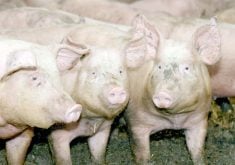A community group fighting a feedlot expansion near Didsbury, Alta., is considering whether to appeal the expansion’s approval.
On April 21 the Natural Resources Conservation Board gave the AAA Cattle Co. the go-ahead to expand to 18,200 head.
Murray Marsh, who farms near the site and belongs to the Committee for Lone Pine, says the fight is not over.
“We have to be able to convince the board that something hasn’t been addressed properly or adequately,” he said.
The 38-member group is talking to legal counsel to see if they can request a board review of the decision by May 12. It has also contacted Alberta Environment over concerns about water supply and quality.
Read Also

The Western Producer Livestock Report – October 2, 2025
Western Producer Livestock Report for October 2, 2025. See U.S. & Canadian hog prices, Canadian bison & lamb market data and sale insight.
The group does not believe the feedlot company has complied with consumption and monitoring conditions attached to its water licence.
“Why should we believe they will begin to adhere to conditions when these documented breaches in the past have occurred and we presume will continue to happen,” Marsh said.
There have been several instances where neighbouring wells have run dry and another neighbour reported bacterial coliforms in well water after the feedlot’s new water system went on-line.
Alberta Environment compliance officer Kevin Pilger said there is an open investigation of the feedlot following the complaints received last year.
“We are in discussions with AAA Cattle and they have made commitments to comply with their licence conditions,” he said.
“The job is not to shut them down but to ensure compliance to ensure protection of the water resources.”
The feedlot has two water licences. The first, granted in 1998, allows it to withdraw 14.3 million gallons per year. Another licence granted in 2002 allows an additional 27.8 million gallons per year.
“Keep in mind their usage is based on consumptive requirements of their cattle,” Pilger said. The NRCB permit allows up to 18,200 head of mostly feeder calves.
The government can issue a series of orders to force compliance when water disputes arise. If there is a failure to comply, the department can go as far as obtaining a court order followed by punitive action if requirements are not met.

















